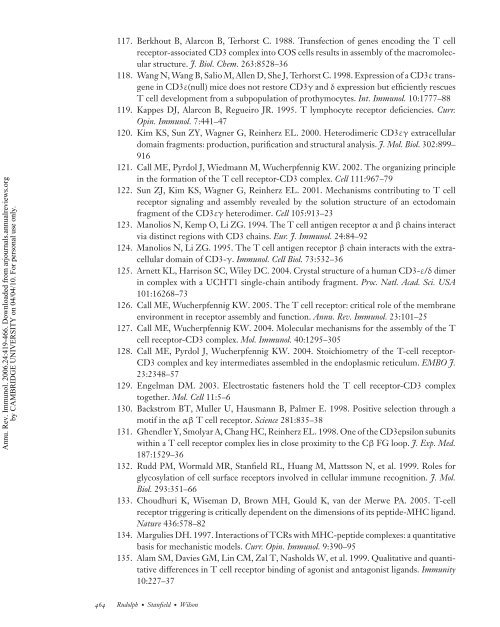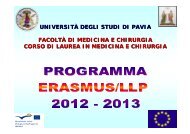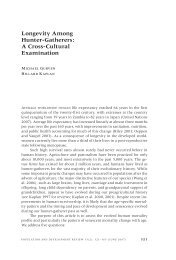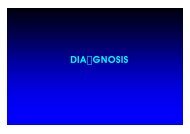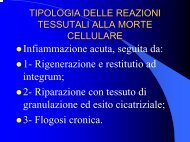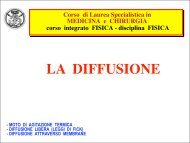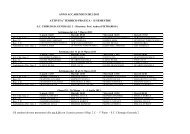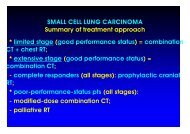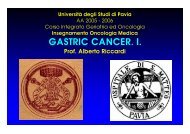Rudolph MG
Rudolph MG
Rudolph MG
You also want an ePaper? Increase the reach of your titles
YUMPU automatically turns print PDFs into web optimized ePapers that Google loves.
Annu. Rev. Immunol. 2006.24:419-466. Downloaded from arjournals.annualreviews.org<br />
by CAMBRIDGE UNIVERSITY on 04/04/10. For personal use only.<br />
117. Berkhout B, Alarcon B, Terhorst C. 1988. Transfection of genes encoding the T cell<br />
receptor-associated CD3 complex into COS cells results in assembly of the macromolecular<br />
structure. J. Biol. Chem. 263:8528–36<br />
118. Wang N, Wang B, Salio M, Allen D, She J, Terhorst C. 1998. Expression of a CD3ε transgene<br />
in CD3ε(null) mice does not restore CD3γ and δ expression but efficiently rescues<br />
T cell development from a subpopulation of prothymocytes. Int. Immunol. 10:1777–88<br />
119. Kappes DJ, Alarcon B, Regueiro JR. 1995. T lymphocyte receptor deficiencies. Curr.<br />
Opin. Immunol. 7:441–47<br />
120. Kim KS, Sun ZY, Wagner G, Reinherz EL. 2000. Heterodimeric CD3εγ extracellular<br />
domain fragments: production, purification and structural analysis. J. Mol. Biol. 302:899–<br />
916<br />
121. Call ME, Pyrdol J, Wiedmann M, Wucherpfennig KW. 2002. The organizing principle<br />
in the formation of the T cell receptor-CD3 complex. Cell 111:967–79<br />
122. Sun ZJ, Kim KS, Wagner G, Reinherz EL. 2001. Mechanisms contributing to T cell<br />
receptor signaling and assembly revealed by the solution structure of an ectodomain<br />
fragment of the CD3εγ heterodimer. Cell 105:913–23<br />
123. Manolios N, Kemp O, Li ZG. 1994. The T cell antigen receptor α and β chains interact<br />
via distinct regions with CD3 chains. Eur. J. Immunol. 24:84–92<br />
124. Manolios N, Li ZG. 1995. The T cell antigen receptor β chain interacts with the extracellular<br />
domain of CD3-γ. Immunol. Cell Biol. 73:532–36<br />
125. Arnett KL, Harrison SC, Wiley DC. 2004. Crystal structure of a human CD3-ε/δ dimer<br />
in complex with a UCHT1 single-chain antibody fragment. Proc. Natl. Acad. Sci. USA<br />
101:16268–73<br />
126. Call ME, Wucherpfennig KW. 2005. The T cell receptor: critical role of the membrane<br />
environment in receptor assembly and function. Annu. Rev. Immunol. 23:101–25<br />
127. Call ME, Wucherpfennig KW. 2004. Molecular mechanisms for the assembly of the T<br />
cell receptor-CD3 complex. Mol. Immunol. 40:1295–305<br />
128. Call ME, Pyrdol J, Wucherpfennig KW. 2004. Stoichiometry of the T-cell receptor-<br />
CD3 complex and key intermediates assembled in the endoplasmic reticulum. EMBO J.<br />
23:2348–57<br />
129. Engelman DM. 2003. Electrostatic fasteners hold the T cell receptor-CD3 complex<br />
together. Mol. Cell 11:5–6<br />
130. Backstrom BT, Muller U, Hausmann B, Palmer E. 1998. Positive selection through a<br />
motif in the αβ T cell receptor. Science 281:835–38<br />
131. Ghendler Y, Smolyar A, Chang HC, Reinherz EL. 1998. One of the CD3epsilon subunits<br />
within a T cell receptor complex lies in close proximity to the Cβ FG loop. J. Exp. Med.<br />
187:1529–36<br />
132. Rudd PM, Wormald MR, Stanfield RL, Huang M, Mattsson N, et al. 1999. Roles for<br />
glycosylation of cell surface receptors involved in cellular immune recognition. J. Mol.<br />
Biol. 293:351–66<br />
133. Choudhuri K, Wiseman D, Brown MH, Gould K, van der Merwe PA. 2005. T-cell<br />
receptor triggering is critically dependent on the dimensions of its peptide-MHC ligand.<br />
Nature 436:578–82<br />
134. Margulies DH. 1997. Interactions of TCRs with MHC-peptide complexes: a quantitative<br />
basis for mechanistic models. Curr. Opin. Immunol. 9:390–95<br />
135. Alam SM, Davies GM, Lin CM, Zal T, Nasholds W, et al. 1999. Qualitative and quantitative<br />
differences in T cell receptor binding of agonist and antagonist ligands. Immunity<br />
10:227–37<br />
464 <strong>Rudolph</strong>· Stanfield· Wilson


